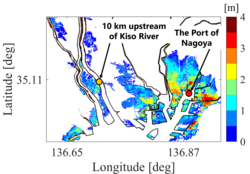
Toyoda, Masaya
| Affiliation | Department of Architecture and Civil Engineering |
|---|---|
| Concurrent post | Research Center for Collaborative Area Risk Management (CARM) |
| Title | Associate Professor |
| Fields of Research | Coastal engineering, Meteorology |
| Degree | Doctor of Engineering (Gifu University) |
| toyoda@ace Please append ".tut.ac.jp" to the end of the address above. |
|
| Laboratory website URL | http://www.umi.ace.tut.ac.jp/ |
| Researcher information URL(researchmap) | Researcher information |
Research
From the field of coastal engineering in civil engineering, I'm conducting studies on meteorological disasters, coastal disasters, and river disasters that occur due to typhoons and extratropical cyclones. I mainly use numerical simulation and data analysis. I'm also working on future climate experiments that take into account the impacts of global warming. The goal of my research is to contribute to society from the study of air, sea, and river basins.
Theme1:Study on compound flood using atmospheric-ocean-river coupling model
Overview
 Inundation map for Ise Bay under high tide conditions in the event of a compound flooding occurring at the end of the 21st century
Inundation map for Ise Bay under high tide conditions in the event of a compound flooding occurring at the end of the 21st centuryThree major bays in Japan (Tokyo Bay, Ise Bay, and Osaka Bay) have cities formed along the coast, and many rivers flow into the sea. In recent years, strong typhoons have attacked Japan and increasing the risk of compound floods. In this research, we aim to elucidate the mechanism of compound flood and evaluate vulnerabilities by calculating three phenomena of typhoon, storm surge, and flood by numerical models.
Keywords
Theme2:Study on future changes in typhoons and storm surges using the pseudo-global warming downscaling method
Overview
There is concern that the intensity of typhoons and the storm surges that accompany them will increase due to the progress of global warming. Disaster prevention against typhoons and storm surges is an issue that should be solved not only in Japan but also in other countries, especially in the northwestern Pacific Ocean. Numerical models for future climate projections are being developed all over the world. However, the results vary by model. This study aims to clarify how much the typhoon intensity and storm surge in the future climate will increase by using a method called "pseudo-global warming downscaling" and future projection data calculated from a large number of models.

